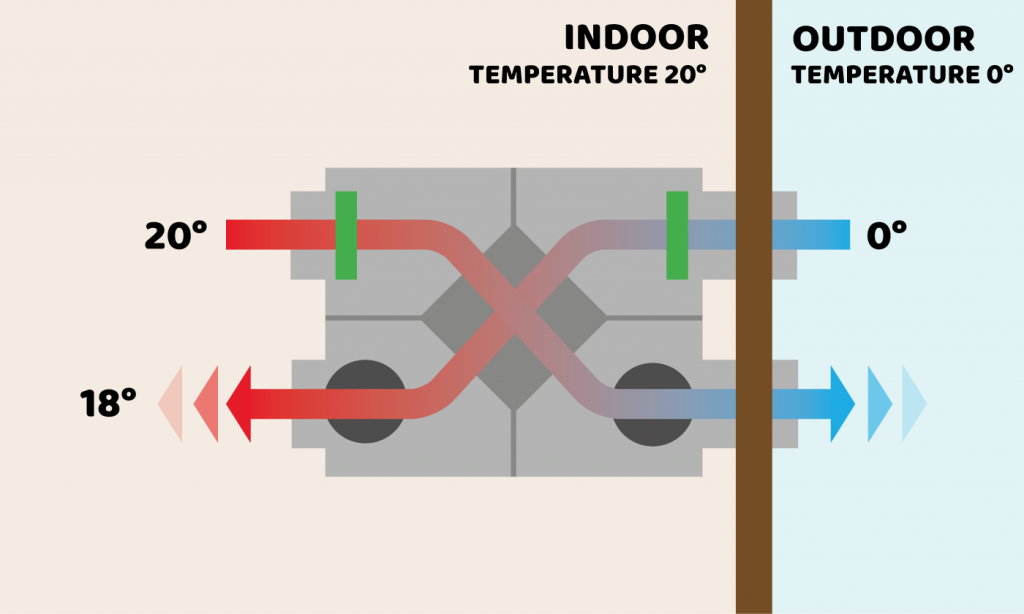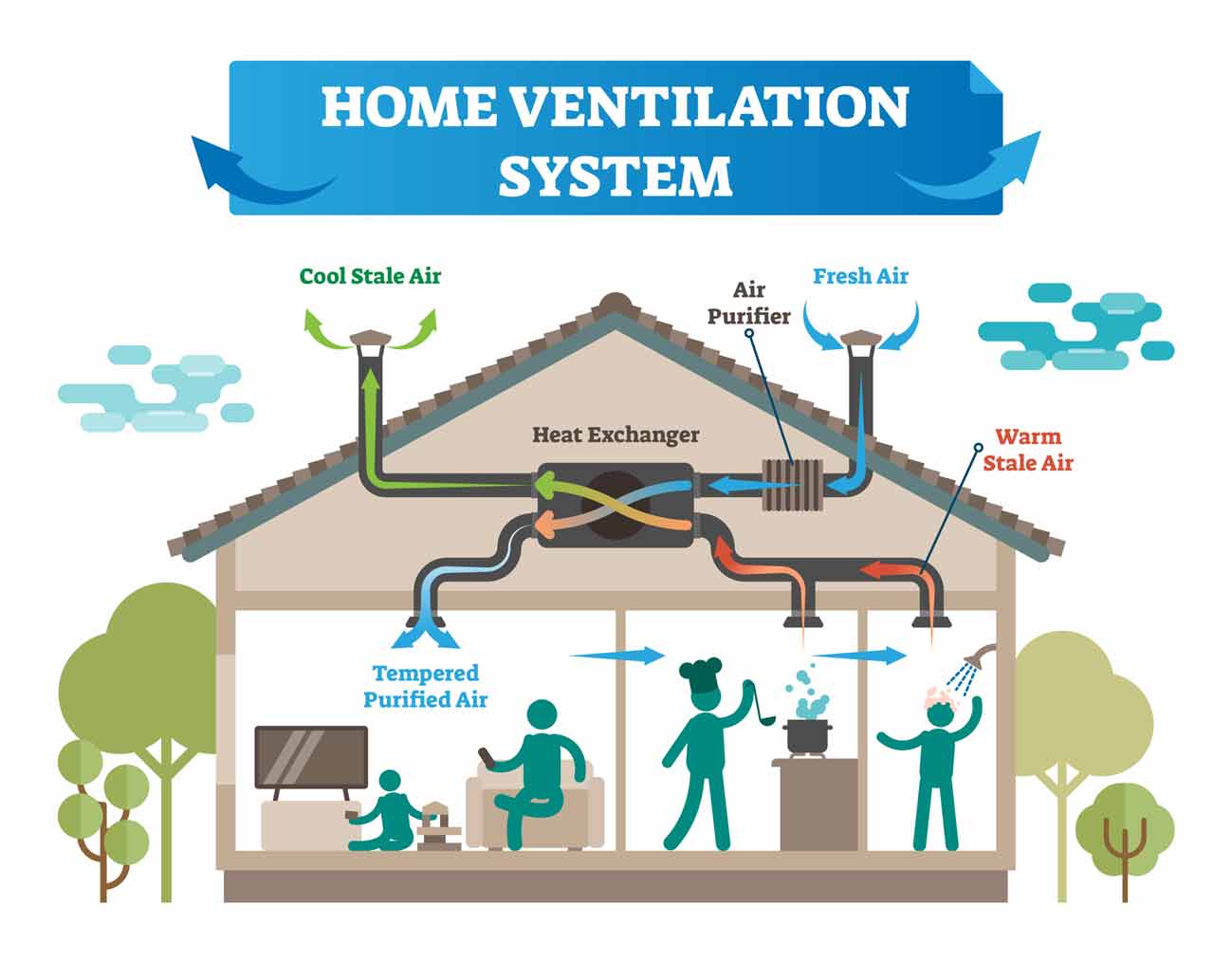HRV Buying Guide: What Features to Check
Wiki Article
Introducing the Key Advantages and Uses of Heat Recovery Ventilation in Lasting Layout
Heat Recovery Ventilation (HRV) systems play a vital duty in sustainable design. They promote a constant exchange of stale indoor air with fresh exterior air, significantly boosting interior air top quality. HRVs add to energy effectiveness by redeeming heat from worn down air, which can lower energy prices. Comprehending the multifaceted benefits and applications of HRVs exposes their importance in modern style. What other advantages do these systems use in the quest of sustainability?Comprehending Heat Recovery Ventilation Equipments
Heat recovery ventilation (HRV) systems are made to improve indoor air high quality while lessening energy loss. These systems use a mechanical air flow strategy to exchange stagnant indoor air with fresh exterior air, ensuring a continuous supply of clean air. By capturing heat from the exhaust air, HRVs prerequisite inbound air, reducing the demand on home heating and cooling down systems. This procedure not only boosts thermal comfort but likewise adds to power performance in property and commercial structures. In addition, HRV systems aid regulate moisture levels and lower indoor toxins, promoting a healthier living setting. Their strategic implementation is necessary for achieving sustainable style objectives, as they supply a balance between energy preservation and resident health.Exactly How HRV Systems Job
While several might know with air flow systems, recognizing exactly how warm recuperation air flow (HRV) systems run is necessary for valuing their benefits. HRV systems operate by trading stagnant indoor air with fresh outside air while moving warm in between the 2 streams. This procedure occurs in a heat exchanger, where warm from the outward bound air warms up the inbound air throughout chillier months, minimizing energy loss. Alternatively, in warmer months, the system can cool incoming air utilizing the cooler outward bound air. HRVs are outfitted with followers to help with airflow and filters to eliminate particulates, making certain a continual, well balanced ventilation procedure. This ingenious style not just enhances power performance but additionally adds to maintaining a comfortable indoor atmosphere.Enhancing Indoor Air High Quality
Interior air high quality can greatly affect wellness and health, making reliable air flow vital in modern-day homes. Heat Recovery Ventilation (HRV) systems play a vital role in keeping indoor air top quality by continuously trading stale interior air with fresh outside air. This procedure not only decreases airborne contaminants however also minimizes humidity degrees, which can cause mold growth and breathing concerns. HRV systems filter inbound air, eliminating allergens and particulates, thus supplying a much healthier living atmosphere. Furthermore, these systems assist eliminate odors and unpredictable organic compounds (VOCs) commonly located in house products. By making certain a regular flow of clean air, HRV systems add to a total improved interior atmosphere, advertising comfort and well-being for owners.Power Efficiency and Price Financial Savings
Power performance sticks out as a considerable benefit of Heat Recovery Ventilation (HRV) systems. By catching and recycling the heat from tired indoor air, HRVs minimize the energy required for heating inbound fresh air, causing reduced energy consumption. This effectiveness equates into reduced utility expenses, using significant price financial savings for home owners and companies alike. Furthermore, HRV systems commonly get approved for energy effectiveness motivations and discounts, additionally boosting their monetary appeal. With time, the initial investment in HRV innovation can cause a positive roi with reduced power expenses. The combination of HRV systems not only promotes sustainable layout yet additionally gives a functional solution for achieving lasting power cost savings and monetary benefits.Ecological Benefits of HRV

A plethora of environmental benefits arises from the execution of Heat Recovery Ventilation (HRV) systems. By successfully moving heat from exhaust air to incoming fresh air, HRVs considerably minimize the energy needed for heating and cooling spaces. This energy performance converts to reduce greenhouse gas emissions, adding to a decrease in the general carbon impact of structures. In addition, HRV systems boost indoor air high quality by continuously circulating fresh air, thus decreasing the concentration of indoor toxins and allergens. The reduction in energy consumption help in preserving natural resources, making HRVs a crucial element of lasting style. Overall, the environmental advantages of HRVs play a crucial function in advertising a healthier world and fostering green structure practices.
Versatile Applications in Modern Style
Heat recovery ventilation (HRV) systems are significantly being incorporated right into both residential and commercial building jobs. In domestic setups, HRVs enhance interior air quality while making the most of power efficiency. Meanwhile, in commercial areas, these systems maximize air flow methods, showing their versatility in modern-day building applications.Residential Projects Assimilation
While contemporary architecture increasingly stresses sustainability, the combination of warmth recuperation ventilation systems in residential projects has become a sensible option for boosting indoor air top quality and power performance. These systems effectively move heat from exhaust air to incoming fresh air, lessening power loss and lowering heating or cooling down needs. In new builds and retrofits alike, warm healing ventilation can be flawlessly included, supplying home owners with a much healthier living atmosphere while decreasing utility expenses. In addition, with boosting recognition of environmental effects, even more designers and contractors are recognizing the long-lasting benefits of these systems. Consequently, warm healing ventilation has come to be an important part of lasting property layout, showcasing convenience and dedication to environment-friendly techniques.Commercial Areas Optimization
As modern industrial spaces evolve to fulfill the needs of sustainability and efficiency, the application of heat recovery ventilation systems emerges as an essential strategy for optimizing indoor environments. These systems facilitate the exchange of stale their explanation indoor air with fresh outside air while recovering heat, significantly lowering energy consumption. This not just boosts comfort for residents however also assists in lowering operational expenses. Functional applications can be observed in offices, retail rooms, and educational organizations, where air high quality and temperature control are critical. Additionally, incorporating warm recuperation air flow lines up with green structure qualifications, further advertising ecological responsibility. Eventually, taking on such systems in business architecture not just adds to sustainability goals yet also fosters healthier, much more effective areas for customers.
Integrating HRV Into Sustainable Design Practices
Integrating heat recuperation ventilation (HRV) systems right into sustainable design Continued practices offers considerable advantages in power effectiveness and interior air quality. By making use of HRV, designers can create affordable solutions that not just lower energy intake but likewise enhance the general comfort of interior atmospheres. This alignment with sustainability goals settings HRV as a vital element in modern architectural methods.
Energy Effectiveness Improvement
By including heat recuperation ventilation (HRV) systems right into sustainable design methods, architects and contractors can considerably enhance power efficiency in modern-day constructions. HRV systems operate by capturing heat from outward bound stagnant air and transferring it to inbound fresh air, reducing the energy needed for home heating or cooling indoor areas. This process not only decreases reliance on typical a/c systems yet likewise reduces overall power usage. In addition, HRV systems can aid keep a regular indoor temperature, minimizing peak energy demands. By incorporating these systems, structures can achieve substantial decreases in energy costs and carbon impacts, aligning with sustainability objectives. Eventually, HRV modern technology stands for a sensible option for boosting energy effectiveness in the developed environment, advertising even more accountable resource use.Indoor Air Quality Enhancement
Just how can warmth recuperation ventilation (HRV) systems add to exceptional indoor air quality in contemporary buildings? HRV systems successfully exchange stale indoor air with fresh outdoor air while recuperating heat, minimizing temperature level fluctuations. This procedure lowers the concentration of interior toxins, such as unpredictable natural compounds (VOCs), allergens, and wetness, which can wear away air high quality and effect resident health. By keeping suitable humidity degrees and making sure a continuous supply of clean air, HRVs aid create a healthier indoor environment. In addition, these systems can be integrated right into sustainable design methods, advertising energy efficiency alongside improved air top quality. HRV Heat Recovery Ventilation. HRV innovation plays an essential role in progressing overall occupant comfort and health in contemporary building styles.Economical Style Solutions

Regularly Asked Concerns
What Upkeep Is Needed for Heat Recovery Ventilation Systems?

Upkeep for warmth healing ventilation systems generally includes regular filter replacements, cleaning of warmth exchangers, examination of followers and ducts, and guaranteeing appropriate water drainage. These jobs aid maintain effectiveness and extend the system's lifespan gradually.
Can HRV Solutions Be Set Up in Existing Buildings?
Heat recovery ventilation systems can indeed be installed in existing structures. HRV Heat Recovery Ventilation. Retrofitting calls for cautious planning and evaluation of the building's design, ensuring compatibility with current systems while maximizing power efficiency and interior air high qualityHow Do HRV Solution Effect Sound Degrees Inside Your Home?
HRV systems can influence indoor sound levels by presenting noise from external sources via ventilation. Nonetheless, high-grade installments frequently include sound-dampening features, minimizing sound impact while giving efficient air exchange and maintaining comfort indoors.Exist Any Drawbacks to Making Use Of HRV Solutions?
The drawbacks of utilizing HRV systems consist of prospective high initial costs, upkeep challenges, and the possibility of decreased interior air high quality if filters are not regularly changed, which might result in problems with humidity degrees.Exactly how Do I Pick the Right HRV System for My Requirements?
Selecting the right heat healing air flow system entails reviewing specific requirements, such as building dimension, environment, and power effectiveness objectives. Furthermore, examining system attributes, setup requirements, and upkeep considerations is vital for peak efficiency and contentment.Report this wiki page